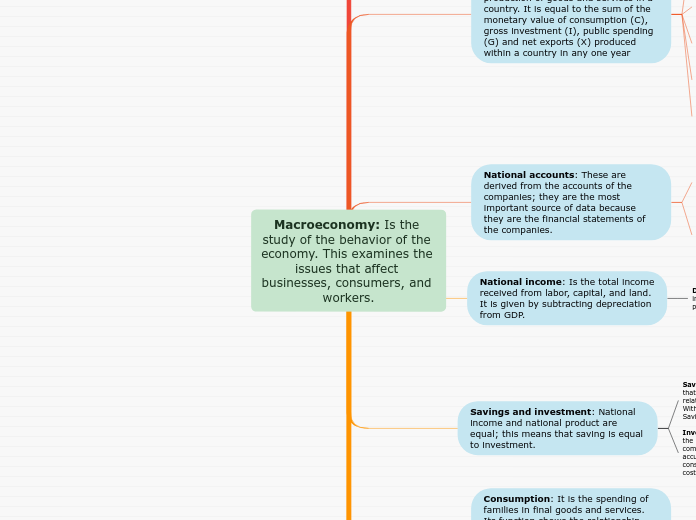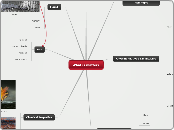Macroeconomy: Is the study of the behavior of the economy. This examines the issues that affect businesses, consumers, and workers.
To name your story, you have to think about the overall message and what you want your audience to understand from the story. Also, make it relevant and easy to remember.
Price stability: It is defined as a low and stable inflation rate
Inflation rate: Percentage change in the general price level from one year to the next
Producer Indices (PPI): Measures the price level at producer or wholesale prices. It is based on more than 8,000 commodities
GDP price indices: It is the price of all goods and services produced in the country instead of a single component.
Consumer Price Index: Measure of the average price paid by urban consumers for a market basket of consumer goods and services.
Price index: It is the weighted average of the price of a basket of goods and services. Economists weight individual prices by the economic importance of each good.
Consumption: It is the spending of families in final goods and services. Its function shows the relationship between the level of consumer spending and the level of personal income. Consumption is divided into three categories: Durable goods, non-durable goods, and services
National consumption function: This shows the function of the level of consumption spending and the level of disposable personal income.
The marginal propensity to consume: It is the extra amount that people consume when they receive an extra monetary unit of disposable income.
Savings and investment: National income and national product are equal; this means that saving is equal to investment.
Investment: investment performs two functions in the macroeconomy: It is an important and volatile component of spending and leads to the accumulation of capital. When investing you should consider three essential elements, such as: income, costs, and expectations.
Income: An investment is profitable when it generates additional income that contributes to a greater sale of products.opic
Saving: It is the part of disposable personal income that is not consumed. The saving function shows the relationship between the level of saving and income. With higher income, saving increases
Savings = income – consumption
Marginal propensity to save: this is defined as the fraction of an additional dollar of disposable income that goes into savings. Each additional dollar of disposable income must be divided by additional consumption and savings.
National income: Is the total income received from labor, capital, and land. It is given by subtracting depreciation from GDP.
Disposable personal income: Market and transfer income received by families are calculated, and personal taxes are subtracted.
National accounts: These are derived from the accounts of the companies; they are the most important source of data because they are the financial statements of the companies.
The ending of a story is essential. We all know that if the ending is weak, what happened before loses its importance. So make it unpredictable, but fair. A resolved ending answers all the questions and ties up any loose threads from the plot.
The “added value” in the lower circuit: The added value is the difference between the sales of a company and its purchases of materials and services from other companies.
This is the closure section of the story.
See examples of possible outcomes below:
- all problems have been solved
- it's clear how each one of your characters ends up
- your main character is transformed by the challenge
The “double counting” problem: A final product is a product that is manufactured and sold for consumption or investment. GDP excludes intermediate goods, goods that are used to make other goods. In calculating GDP from the product flow side, the exclusion of intermediate products does not pose any major complications.
This is the moment when the main character surpasses the last obstacle and finally faces their greatest challenge.
The climax usually follows one of these patterns:
- realization
- resolution
- choice
Type in your answer.
Gross Domestic Product (GDP): Is the measure that covers the total production of goods and services in a country. It is equal to the sum of the monetary value of consumption (C), gross investment (I), public spending (G) and net exports (X) produced within a country in any one year
The middle of the story is where you add layers of complications that will lead to the end. Reveal more about the character's journey. Did their personality go through changes? How did they overcome the challenges? And as you build up the story’s central conflict, make it more personal to that character. Also, from the middle act, you have to lead into the final act.
Gross National Product (GNP): it is the total final product produced with inputs that are owned by the residents of this for one year.
Net Domestic Product (NDP): is the total final product produced within a country during a year, where production includes net investment, or gross investment minus depreciation
Real GDP: This removes price changes from nominal GDP and calculates GDP in terms of the quantities of goods and services.
There wouldn't be any tension and excitement in your story if there weren't any obstacles in your character's way.
Nominal GDP: Represents the total value in money of the final goods and services produced in a respective year, where the values are expressed in terms of market prices for each year.
Your character(s) need(s) motivation in order to solve the challenge(s).
Measurement
Each story has a main character and that character usually needs to solve a problem or challenge. The character's challenge is the one that creates tension throughout the story.
Income approach: It is the annual luxury of production costs, where all the costs of doing business flow, being the total income of the factors (wages, interests, rents, and profits) that are the costs of obtaining the final products of society
Type in any other challenges which other characters in the story need to face.
Product flow approach: buyers acquire the final and consumed goods and services almost immediately; families spend their income on these consumer goods
In most stories, there are 3 challenges. The number 3 is a mystical number symbolizing completeness. Try to come up with interesting challenges with which your character needs to struggle.
See a few examples below:
- turns into a werewolf at night
- is sent back in time
Offer and demand
In the beginning of the story (or the exposition), you will need to introduce the setting and characters. You might also want to introduce the main conflict. This part of the story is important because it gives the reader necessary background information and maybe even a first insight into a character’s personality.
Demand: It is the amount of goods that individuals acquire depending on their price. If the market value is low, more units are acquired.
Income effect: This occurs when the price of goods rises, and one is somewhat poorer than before
Substitution effect: This occurs because goods become relatively more expensive when their price rises
Offer: The producers offer goods to make a profit










